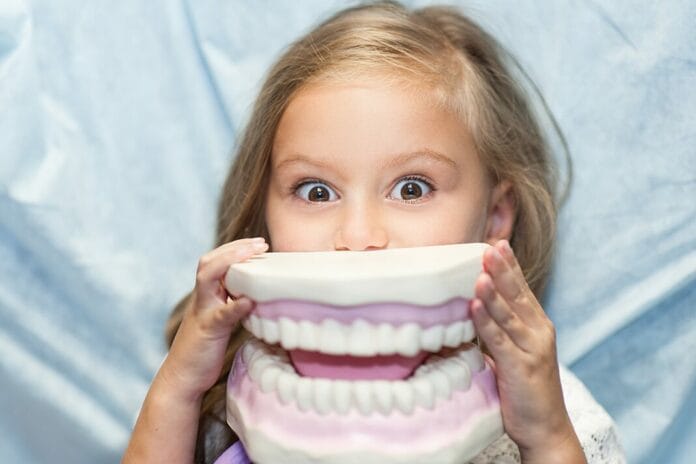February is National Children’s Dental Health Month, and if you are like me, you scour the internet for presentation ideas as you prepare to reach out to the youth in your area. For years, I have been going to the local elementary school to give a presentation to at least one grade level. Over the years, I have accumulated materials, ideas, and experience. So, consider this your unofficial guide to National Children’s Dental Health Month.
Before we get into the fun stuff, let’s talk logistics. Just over half of children ages six to eight have had decay in at least one of their primary teeth.1 That’s incredibly too much, especially when tooth decay is preventable. Sadly, dental decay remains the most chronic disease of children in the United States.2 Children with poor oral health are more likely to experience tooth pain and miss school compared to those with better oral health status.3
I urge you to take this unfortunate yet imperative knowledge and use it as fuel to help educate children in your area. Be a beacon of light in a tunnel of dark.
National Children’s Dental Health Month Presentation Ideas
Now, to the fun stuff! I have collected all the ideas that I have used in the past to share. You may have already used some of these ideas, but hopefully, you will find a new idea to spark an entertaining presentation.
1) Proper brushing technique demonstration
This is a simple yet imperative demonstration. Remember, sometimes less is more. Using a typodont of sorts, show children the proper way to brush their teeth. I found a rather large one online that was accompanied by a large brush to help demonstrate the correct method. Never underestimate this simple act.
This is also a perfect way to help children formulate a routine to ensure they brush all of their teeth. Many children skip around when brushing and unknowingly miss areas. I have found that many children are unaware they need to brush the linguals of their teeth. And let’s be frank, younger children love the big teeth model!
2) Discuss foods to avoid or limit
While this knowledge is a no-brainer for us, it doesn’t come so readily to children. When prompting children to give suggestions of healthy and non-healthy foods, you are afforded the opportunity to educate them about specific foods and drinks.
One cute way of illustrating this is to create a pictorial of foods and beverages that can be attached to a board by volunteers from the class in the appropriate section of healthy or not healthy. For example, gummy snacks would be placed under the “cavity creator” side, while broccoli would be placed under the “healthy for me” side. This activity educates children on making better choices.
3) Acid demonstration
Demonstrating acid production in the mouth has never been more fun than with this experiment. Use a styrofoam cup to represent the tooth. Place the cup in a glass bowl or metal pan. Use corn syrup as a sticky substance that children eat. Then, throw in some sprinkles to represent sugar, such as a cupcake. Using great care, pour pure acetone over the cup to represent the acid that is produced by these two substances on the tooth. The cup will dissolve before their eyes!
This experiment is a show-stopper. Children are not only in awe of the disappearing cup but also learn a valuable piece of knowledge on how teeth are affected by acid.
4) The importance of nightly brushing
Days prior to your presentation, take bits of food and milk and add them to a Ziploc bag. Zip the bag, but leave a small opening for air to enter. Leave the bag out so the contents will begin to spoil and become stinky.
When presenting to the students, talk about eating all day and not brushing their teeth. Allow children to smell the contents of the bag and compare this to the plaque and bacteria they allow to sit on their teeth at night.
This is also a great opportunity to use the wonderful yet hilariously true phrase, “When you don’t brush and floss before bed, bacteria poops acid in your mouth all night.”
5) Interdental cleaning demo
Using a glove on your hand, ask for a volunteer to spread peanut butter on the gloved hand. Then, ask another volunteer to clean the hand using a wet towel or a brush. During the cleaning process, make sure to keep your fingers together. Once the glove is remotely clean, spread your fingers so the students can see the peanut butter left behind. Seeing what’s left behind is a great demonstration of interdental cleaning or lack thereof.
6) Sugary beverages
To determine the amount of sugar in various beverages, place the amount of sugar in each beverage in a labeled bag. Present this to the students while explaining how acidic, sugary beverages affect their teeth and the importance of moderation.
Seeing is believing, and you might just find yourself gasping at the amount of sugar in each beverage.
7) What to expect at your dental visit
Wearing your scrubs, bring along your lab coat, glasses/loupes, mask, gloves, and a mirror and explorer to your presentation. As you place each item on, describe each item and what it is used for so that much younger crowds will be familiar with what to expect prior to attending a dental appointment.
Allow students to see items they will encounter at the appointment, such as a mirror, explorer, and any other items you choose to bring. This is helpful for three to five-year-old children as many, unfortunately, have not made it to the dentist at this point. While we may feel our office get-up is normal, we can appear quite scary to a child who has never been to the dentist.
In Closing
Hopefully, these presentation ideas will assist you in your efforts to educate the children in your community. Remember, when speaking to younger crowds, attention spans are limited. Make sure to address the key points before losing your crowd’s focus. Use child-friendly vocabulary and analogies they can relate to and understand. Adjust your presentation material to your age group. Many materials can be acquired online from various companies that can be left with the teacher.
Click here for additional information and materials from the American Dental Association that can be accessed for your use.
If the resources exist, it is always a nice gesture to leave some sort of token for each child, such as a toothbrush or a brushing timer. During your presentation, remember to smile and have fun!
Before you leave, check out the Today’s RDH self-study CE courses. All courses are peer-reviewed and non-sponsored to focus solely on high-quality education. Click here now.
Listen to the Today’s RDH Dental Hygiene Podcast Below:
References
- Dental Caries (Tooth Decay) in Children Ages 2 to 11 Years. (2022, November). NIH: National Institute of Dental and Craniofacial Research. https://www.nidcr.nih.gov/research/data-statistics/dental-caries/children#dental-caries-in-the-primary-teeth-children-ages-6-to-8-years
- Policy on Oral Health Care Programs for Infants, Children, Adolescents, and Individuals With Special Health Care Needs. (2024). American Academy of Pediatric Dentistry. https://www.aapd.org/globalassets/media/policies_guidelines/p_oralhealthcareprog.pdf
- Policy on School Absences for Dental Appointments. (2023). American Academy of Pediatric Dentistry. https://www.aapd.org/globalassets/media/policies_guidelines/p_schoolabsences.pdf











